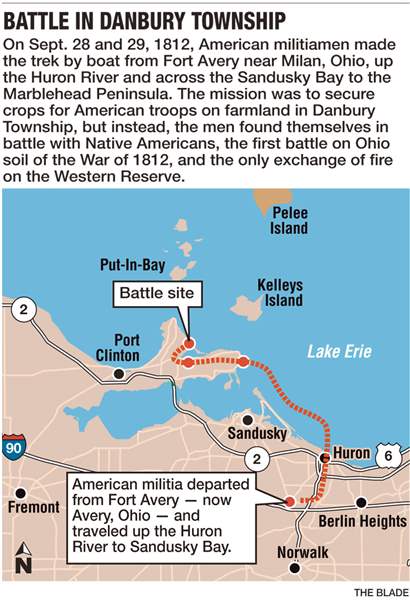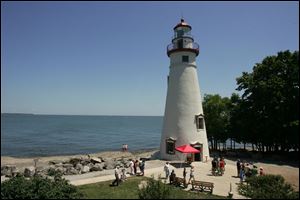
1812 battle at Marblehead to be re-enacted
9/17/2012

Historic re-enactors plan to recreate the Marblehead battle as it occurred Sept. 28 and 29, 1812, during an event this weekend at the Wolcott Keeper's House, 9999 E. Bayshore Rd. The battle reenactments will be held both Saturday and Sunday, and will be part of a bigger event that includes demonstrations, camp crafts, food, and historical speakers.
MARBLEHEAD — At the young age of 16, Army Private Joshua Giddings walked along the edge of the Marblehead peninsula, musket positioned mid-shoulder at the ready, a band of crouching Native Americans hidden from view in the tall marsh grasses nearby.
"The ground was open timberland, with grass as high as a man's waist. The Indians rose from the grass directly in front of the party, and fired as simultaneously as a platoon of militia would have fired at the word command," Pvt. Giddings wrote in an account almost two centuries ago that chronicles the two-day battle, that came to be known as the "skirmish on the peninsula."
It was the first battle of the War of 1812 on Ohio soil and it happened between American militiamen and Native Americans who were British sympathizers near the undeveloped land that is now the popular site of East Harbor State Park in Danbury Township on Sandusky Bay. About eight miles southeast of the park, eight young soldiers who lost their lives in the battle are buried at Battlefield Park. About 40 Native Americans also died in the battle.
Historic re-enactors plan to recreate the battle as it occurred Sept. 28 and 29, 1812, during an event this weekend at the Wolcott Keeper's House, 9999 E. Bayshore Rd. The battle reenactments will be held both Saturday and Sunday, and will be part of a bigger event that includes demonstrations, camp crafts, food, and historical speakers.
"Our purpose here is to commemorate all 48, all the young men who died searching for an ideal for their nation, and defending a way of life they held there," said retired Ottawa County Common Pleas Judge Paul Moon, who is the president of the county's historical society.
It was Pvt. Giddings — who later became a member of the Ohio House of Representatives and then a U.S. Congressman in 1838, and who was a prominent opponent of slavery serving for a period under President Abraham Lincoln - who took a pen to paper and wrote an account of the battle and what he and fellow troops encountered over those two days.

"The night was dark and the march was slow," he described of the troops who headed west on foot after snaking their way by small, wooden boat up the Huron River to the Sandusky Bay, where they landed across from what is now the Keeper's House. The home of the first Marblehead Lighthouse keeper, Benajah Wolcott, had already been abandoned by Mr. Wolcott and his his family, who feared attacks by the British and their Native American allies.
The mission on the peninsula, he wrote, was not to engage in battle with the Native Americans, but to secure crops that had not yet been harvested at the farm of Valentine Ramsdell, who later joined the troops in battle and was one of the men killed by the opposition. Mr. Ramsdell's farm sat on a plot of land that is now East Harbor park, and was enticing to American troops affected by what was known as the "Little Ice Age," Judge Moon said, a period in which an unusual cold spell covered the region.
"The crops that were planted, the seeds wouldn't germinate, and the crops that grew did not come to fruition," Judge Moon said, adding that Mr. Ramsdell's crops flourished because they were surrounded by water and therefore more moderate temperatures.
But when troops arrived at the farmhouse, the militiamen found a fire still burning, half-eaten food laying on the land, said Brian Porter, who lives in Danbury Township and is organizing the re-enactment.
"It was clear to the Americans that the Native Americans had just left," he said.
It wasn't long after, as the militia members headed back to their departure point that they were shot upon by the Native Americans hiding in the marshland.
"Everyone knew it was coming, but no blood had been shed yet," Mr. Porter said. "When this battle happened, it was a turning point - from politicians talking about 'what we should do,' to 'this is really happening,' " Mr. Porter said.
Mr. Giddings later funded the construction of a monument, honoring the Americans who died, that still stands at Battlefield Park. It will be the site of this weekend's event, which will include main speaker, Lorin Swinehart of Piqua, an adjunct professor at Ashland University, and an author of books and articles on U.S. and Native American topics. U.S. Rep. Marcy Kaptur (D., Toledo) will attend a memorial service and rededication of Giddings Monument at 2 p.m. Saturday.
A $1,500 grant from the Ohio Humanities Council, and several local donors, will help fund the weekend, said spokesman Kathy Leonard.
About 60 re-enactors are coming from Michigan, New York, Pennsylvania and from all over Ohio to create the battle for guests. The uniforms, the tents, the location, will help re-enactors provide the most accurate portrayal possible of what happened 200 years ago, Mr. Porter said.
"If a spectator watches, they will visually be able to see what happened that night, without the disease and bullets," he said.
Contact Roberta Redfern at:
rredfern@theblade.com
or 419-724-6081.